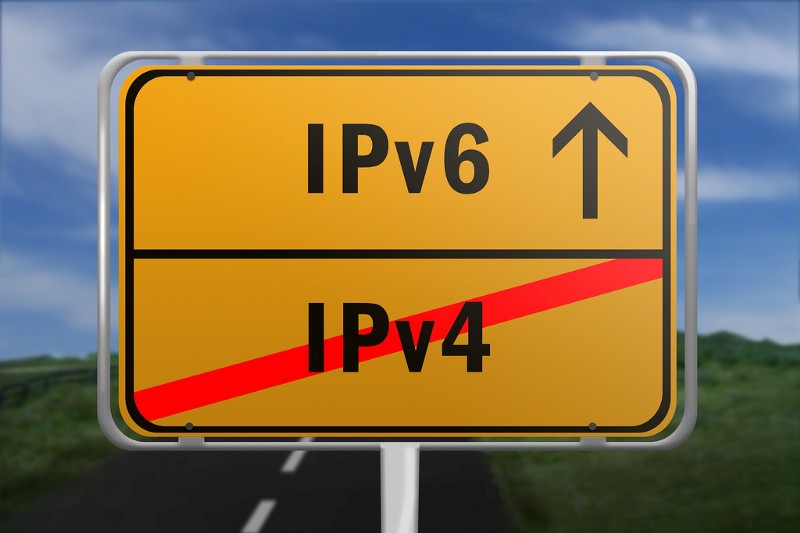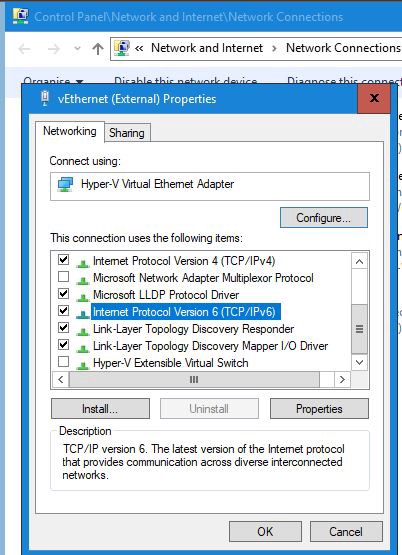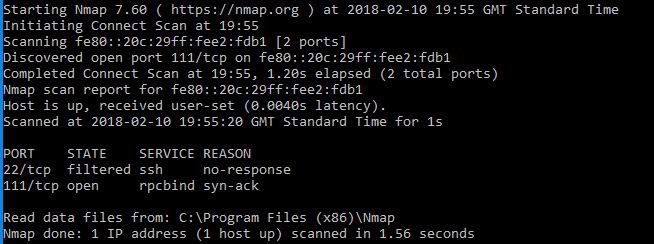Hacking IPv6 from Windows

The last article drew some constructive criticism that some penetration testers prefer (or are stuck with) using Windows, and that we had intentionally left the Windows Operating System out. Hopefully, this post will alleviate those concerns…
So here we go, IPv6 in Windows 10 should be supported straight out of the box. But if you want to double check, go to:
- Control Panel
- Network Connections
- Change adapter options
- Locate your interface, right-click and properties
- Look for the IPv6 module, ensure there is a tick in the box

IPv6 Addressing
More on IPv6 addressing, and various formats can be found here: https://en.wikipedia.org/wiki/IPv6_address
Get your IPv6 address
ipconfig
Below is the basic usage of the ipconfig command to determine your IPv6 address:
$ ipconfig
Example:
$ ipconfig
Ethernet adapter vEthernet (External):
Connection-specific DNS Suffix . : test.local
Link-local IPv6 Address . . . . . : fe80::75f8:76d4:930e:19d5%26
IPv4 Address. . . . . . . . . . . : 10.2.66.190
Subnet Mask . . . . . . . . . . . : 255.255.224.0
Default Gateway . . . . . . . . . : 10.2.95.254
netsh
To get the most out of Windows and IPV6, you are going to have to learn how to use the netshell command or netsh.
Show your interfaces:
$ netsh int ipv6 show int
Idx Met MTU State Name
--- ---------- ---------- ------------ ---------------------------
10 5 1500 disconnected Ethernet
1 75 4294967295 connected Loopback Pseudo-Interface
26 25 1500 connected vEthernet (External)
Warning: You may have many interfaces if you have Hypervisors and Docker installed. The list above has been trimmed to make it easier to read. But the task ahead of you to identify the correct interface and IP address may be harder?
Show your IPv6 addresses:
netsh int ipv6 show address
Example of a static configured host:
netsh int ipv6 show address
Interface 26: vEthernet (External)
Addr Type DAD State Valid Life Pref. Life Address
--------- ----------- ---------- ---------- ------------------------
Other Preferred infinite infinite fe80::75f8:76d4:930e:19d5%26
Using route
Display IPv6 route
Display your Windows IPv6 routing table:
$ route print -6
Example. Here you see different IPv6 routes for different interfaces on Windows.
$ route print -6
====================================================================
Interface List
10...f0 de f1 1a 14 f9 ......Intel(R) 82577LM Gigabit Network
26...00 23 14 da 5e 90 ......Hyper-V Virtual Ethernet Adapter
1...........................Software Loopback Interface 1
====================================================================
IPv6 Route Table
====================================================================
Active Routes:
If Metric Network Destination Gateway
1 331 ::1/128 On-link
26 281 fe80::/64 On-link
26 281 fe80::75f8:76d4:930e:19d5/128
On-link
26 281 ff00::/8 On-link
====================================================================
Persistent Routes:
None
Alternatively the same command with netsh
$ netsh interface ipv6 show route Publish Type Met Prefix Idx Gateway/Interface Name ------- -------- --- ------------------------ --- ------------------------ No System 256 ::1/128 1 Loopback Pseudo-Interface 1 No System 256 fe80::/64 10 Ethernet No System 256 fe80::/64 26 vEthernet (External)
IPv6 Tools
IPv6 Ping
ping -6 [ipv6address] ping -6 [link-local-ipv6address]
Example:
$ ping -6 ::1
Pinging ::1 with 32 bytes of data:
Reply from ::1: time<1ms
Reply from ::1: time<1ms
Reply from ::1: time<1ms
Reply from ::1: time<1ms
Ping statistics for ::1:
Packets: Sent = 4, Received = 4, Lost = 0 (0% loss),
Approximate round trip times in milli-seconds:
Minimum = 0ms, Maximum = 0ms, Average = 0ms
IPv6 Traceroute
tracert -6 [ipv6address] tracert -6 [link-local-ipv6address]
Example:
tracert -6 ::1 Tracing route to Andys-Laptop [::1] over a maximum of 30 hops: 1 <1 ms <1 ms <1 ms test-laptop [::1] Trace complete.
Neighbour Discovery
With the following command you can display the learnt or configured IPv6 neighbours:
$ netsh int ipv6 show neigh
The following example shows neighbors on interface 26, which is a reachable router
$ netsh int ipv6 show neigh 26
Internet Address Physical Address Type
-------------------------------------------- ----------------- -----------
fe80::f841:cd78:7c8a:e20d 00-00-00-00-00-00 Unreachable
ff02::1 33-33-00-00-00-01 Permanent
ff02::2 33-33-00-00-00-02 Permanent
ff02::16 33-33-00-00-00-16 Permanent
ff02::fb 33-33-00-00-00-fb Permanent
ff02::1:2 33-33-00-01-00-02 Permanent
ff02::1:3 33-33-00-01-00-03 Permanent
ff02::1:ff01:228 33-33-ff-01-02-28 Permanent
ff02::1:ff0e:19d5 33-33-ff-0e-19-d5 Permanent
ff02::1:ff14:322c 33-33-ff-14-32-2c Permanent
ff02::1:ff7e:ff50 33-33-ff-7e-ff-50 Permanent
ff02::1:ff8a:e20d 33-33-ff-8a-e2-0d Permanent
ff02::1:ffb1:992d 33-33-ff-b1-99-2d Permanent
ff05::c 33-33-00-00-00-0c Permanent
Adding Manual Routes/Neighbors
Windows Auto-Magic
Windows is an odd beast? when it comes to routing as this appears to be handled automatically. As soon as you discover a link-local host, simply try to ping it, it takes a few packets but windows should automatically add the IPv6 address to the list of known neighbours
>ping -6 fe80::20c:29ff:fee2:fdb1
Pinging fe80::20c:29ff:fee2:fdb1 with 32 bytes of data:
Destination host unreachable.
Destination host unreachable.
Destination host unreachable.
Destination host unreachable.
Ping statistics for fe80::20c:29ff:fee2:fdb1:
Packets: Sent = 4, Received = 0, Lost = 4 (100% loss),
>ping -6 fe80::20c:29ff:fee2:fdb1
Pinging fe80::20c:29ff:fee2:fdb1 with 32 bytes of data:
Destination host unreachable.
Reply from fe80::20c:29ff:fee2:fdb1: time=37ms
Reply from fe80::20c:29ff:fee2:fdb1: time=3ms
Reply from fe80::20c:29ff:fee2:fdb1: time=4ms
Ping statistics for fe80::20c:29ff:fee2:fdb1:
Packets: Sent = 4, Received = 3, Lost = 1 (25% loss),
Approximate round trip times in milli-seconds:
Minimum = 3ms, Maximum = 37ms, Average = 14ms
Windows Manually Adding Routes
>netsh int ipv6 del route [prefix] [interface_string] [next_hop]
Example
>netsh int ipv6 add route fe80::/16 “vEthernet (External)” fe80::20c:29ff:fe25:2403 Ok.
Windows Manually Deleting Routes
>netsh int ipv6 del route [prefix] [interface_string] [next_hop]
Example:
>netsh int ipv6 del route fe80::/16 “vEthernet (External)” fe80::20c:29ff:fe25:2403 Ok.
Other IPv6 Tools
Since Windows is more GUI driven on the User experience level, we do not have the luxury of many and different default command line tools . For viewing web-pages we prefer to use either Chrome/Firefox/Edge.
Just remember to encapsulate the address in square brackets ‘[ ]’
For example Google: https://[2a00:1450:4009:808::200e]/
Other tools
Using 3rd party tools (or Chocolately package manager) you can install familiar tools for accessing the usual services over IPv6.
Nmap and putty
Nmap:

Putty:

Conclusion
Hopefully, this was enough of an introduction for the more Windows orientated penetration testers to progress with and have a play? Not only to prepare for the future, but also for self development.
Share on: